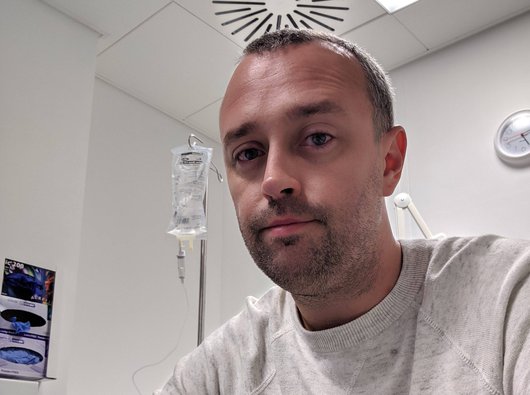Myeloma tests
Doctors will run a range of tests to confirm whether you have myeloma, and if so, whether it needs treatment right away.
Why you need tests
You need tests to decide whether you have:
- active myeloma that needs treatment
- smouldering myeloma that doesn’t need treatment now but may in the future
- MGUS, a condition that doesn’t need treatment but which can lead to myeloma in a small number of cases (one in a hundred each year).
Some of the tests on this page will be repeated regularly to monitor the myeloma and decide when to start treatment. Some will be done during and after treatment to see how well the treatment has worked and if you are in remission (where there are few or no myeloma cells left).
Ask your hospital team to explain what tests you are having and what they are for.
Screening tests
Screening tests are the first tests you’ll have to investigate if you have myeloma or a related condition.
Full blood count
A full blood count or FBC is a simple blood test which aims to measure how many of each type of cell there is in your blood.
An FBC will check whether you have anaemia, which can make you feel tired and short of breath. Anaemia is caused by a low level of red blood cells and is common in myeloma.
If doctors see anything unusual in the results of an FBC, they will order more tests to investigate further. An FBC is often the start of the process of getting a diagnosis, sometimes by chance, because someone has needed a blood test for another reason.
If you go on to get a diagnosis of myeloma and have treatment for it, you will have regular FBCs to help check how well the treatment is working.
Other blood tests
You will have a range of other screening tests. These are usually blood tests:
- Total immunoglobulin levels: this measures the level of normal antibodies in your blood. If one of more of these levels is too high or too low, this may suggest a diagnosis of myeloma.
- Serum protein electrophoresis: this test measures the level of paraprotein in your blood. This will help doctors decide if you have myeloma and if you need treatment.
- Immunofixation: this shows the type of paraprotein in your blood. This information helps doctors work out your treatment plan. It can also detect if you still have a paraprotein left after treatment, if it is too small to measure by serum protein electrophoresis.
- Serum free light chain or SFLC (also called light chain assay): this shows if there are small proteins called light chains in your blood, which is common in myeloma. If you have light chains in your blood but no paraprotein, this may mean you have a type of myeloma called light chain myeloma.
- Serum calcium test: this test checks your calcium level. If there is more calcium than usual in your blood, it can be a sign of bone damage caused by myeloma.
- Urea, creatinine and electrolytes test: this test looks at the level of these substances in your blood and gives doctors information about how well your kidneys are working.
If you have bone or kidney damage that needs treatment, you may be referred to an orthopaedic surgeon (a bone specialist) or a nephrologist (a kidney specialist) as well as seeing a haematologist (a specialist in blood diseases). See our page on treatments for the effects of myeloma.
You may also be referred to a clinical oncologist if your doctor feels you may need radiotherapy as part of your treatment.
If doctors suspect you have myeloma after the screening tests, they will do more tests to confirm the diagnosis and find out more. These tests will also help doctors decide when and how to treat you.
Bone marrow biopsy
Plasma cells are usually found in the bone marrow, not in the blood. So to confirm your diagnosis and investigate further, doctors will need to take samples of your bone marrow. This procedure is called a bone marrow biopsy. This isn’t a test in itself, just a way of collecting samples to test in the laboratory.
The samples are taken from the back of your pelvis (the ring of bones at the base of your spine). One sample is taken using a thin needle (an aspirate) and another using a thicker one (a trephine) to get a larger “core” of bone marrow.
You may find it helpful to read our information about bone marrow biopsies and talk things through with your hospital team or our Support Service.
Your bone marrow samples will be studied under a microscope to see if there are any myeloma cells, how many there are, and find out more about the genetic changes in these cells.
Bone marrow biopsies are sometimes done at intervals, especially if you start treatment. Your doctor will try to keep the number of bone marrow biopsies to the minimum needed.
"It made a big difference to me when someone showed me how to breathe properly with gas and air. So if you’re offered that, ask how to use it for maximum effect."
Scott, living with myeloma since 2019
Read Scott’s story: What I’ve learned as a gay man with blood cancer

Scans and X-rays
You may have a CT, PET-CT or MRI scan to look for signs of bone damage. Your whole body will be scanned, and specific areas may be looked at in more detail.
Sometimes your doctor may also ask for X-rays of some of the bones in your body to look for areas of myeloma. This is called a skeletal survey.
If you have non-secretory myeloma, a type of myeloma where there are no paraproteins in the blood, scans are essential to show the progress of the myeloma and make decisions about treatment.

Order your free guide to myeloma
Includes myeloma treatments, living well with myeloma and questions to ask your medical team.
Genetic tests
All cancers involve genetic changes in particular cells during a lifetime. We don’t know why this happens in an individual person, but knowing which genes are affected helps doctors give a specific diagnosis, get more information about how the myeloma might develop, and in some cases, decide which treatment is likely to work best.
You may have a FISH (fluorescence in situ hybridisation) test. This analyses genetic changes in the myeloma cells. It's done using bone marrow samples taken during a bone marrow biopsy.
B2M and albumin test
These are blood tests that measure the levels of two proteins in the blood: albumin and beta-2 microglobulin or B2M (sometimes written as ß2M). In myeloma, albumin levels can be lower and B2M levels can be higher than normal.
These results of these tests give more information about the status of the myeloma now and what’s likely to happen in the future (your prognosis).
Lactate dehydrogenase (LDH) test
This is a blood test that measures the level of a substance called lactate dehydrogenase (LDH) in the blood. If the level is higher than normal, it’s a sign of cell and tissue damage. This gives more information about your prognosis.
Tests to monitor myeloma
After you have been diagnosed, you may need regular tests to monitor the myeloma. This will happen if you don’t need treatment yet, and also if you are having check-ups after treatment.
Tests used to monitor myeloma include:
- full blood count (FBC)
- serum protein electrophoresis
- immunofixation (in some cases)
- serum free light chains
- serum calcium test
- urea, creatinine and electrolytes test
See screening tests for more information about what these regular tests are for.
You may also have urine tests, more scans and bone marrow biopsies if your doctor thinks these are needed.

Get a weekly support email from us
We'll send you clear and simple information, practical tips, and advice from other people with blood cancer, to help during the first few weeks and months after diagnosis.
